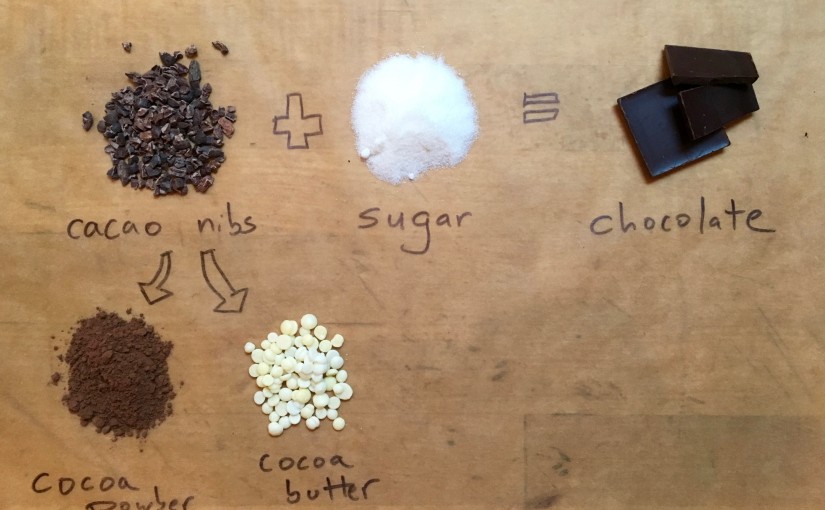Psst… I’ll be on Science Friday today to talk about this and more — tune in at 3:40 pm Eastern Time! -Jeff
A bar of dark chocolate is amazing—but it wasn’t always this way. Back in 1879, a Swiss entrepreneur by the name of Rudolph Lindt invented a refining process call conching that took gritty, granular chocolate and turned it into the deliciously smooth bars that we enjoy today.
When working on the second edition of Cooking for Geeks , I wondered: what was chocolate like before Lindt’s discovery? And just how hard is it to conche your own chocolate?
Let’s start with fun trivia about the components of chocolate before digging into a simple do-it-yourself version:
-
Cacao Nibs
are the dried, fermented seeds of the cacao plant.
- Language geeks: Note the spelling: cacao vs cocoa. Cacao generally refers to parts of the plant and cocoa refers to edible food products. The letter transposition likely occurred in 1755 by dictionary maker Samuel Johnson on page 401 due to the Spanish spelling.
- Old-fashioned Coca-Cola bottles , with their ribbed shape, are a reference to cacao pods—inspiration by proximity in the dictionary; the cacao tree has nothing to do with coca bush.
-
Cocoa butter, a.k.a. cocoa fat
, is the fat from the cacao nibs. Sometimes we forget: plants have fats!
- Fats are triglycerides; in the case of cocoa fat, the most prevalent triglycerides are myristic, oleic, and palmitic acid. Butter—as in cow, not cocoa—has a very similar fat composition, hence the similarities in melting temperatures.
- The exact ratios of the triglycerides in cacao seeds will depend on the climate in which the plant lives. Cooler climates (i.e. higher elevations or geographic variations) will create a fat composition that has a lower melting point.
- Cocoa butter tastes sorta like shortening. It’s not that delicious.
- White chocolate is cocoa butter, sugar, and often flavorings like vanilla. Technically it is chocolate—it has parts of the cacao plant—but some may disagree.
-
Cocoa powder
is the dried, dark solids of the cacao nibs—hence it’s sometimes call
cocoa solids
.
- If you’re a baker and have wondered what Dutched cocoa powder is: it’s cocoa powder processed to improve solubility (it’ll mix better—it’s more hydrophilic) and alter its flavor. (The Dutching process raises the pH of cocoa powder, which is why Dutched cocoa powder shouldn’t be substituted for regular cocoa powder in baked goods that rely on it to react with baking soda.)
-
Bittersweet chocolate
is the combination of cocoa fat, cocoa powder, and sugar. Sometimes flavorings like vanilla are added in; sometimes emulsifiers as well.
- There’s no legal definition specific to bittersweet chocolate, but as a guideline, bittersweet chocolate is typically 30% cocoa fat, 40% cocoa powder, and 30% sugar.
- When you see a bar of chocolate that says “70% bittersweet chocolate,” that’s the amount of cocoa fat and cocoa powder. One manufacturer’s 70% might be 30% fat, 40% powder; another’s could be 35% fat, 35% powder. Because cocoa powder is bitter and cocoa fat is not, a 70% bar made with more cocoa powder and less cocoa butter will taste more bitter, even though both bars are “70% bittersweet.”
Ok, so hopefully that clears up some common confusion around spellings, differences in ingredients, and other “base knowledge” parts of chocolate.
Ok, great—so how do I make a bar of delicious bittersweet chocolate?
- Take the cacao nibs, warm them, and slowly grind them for many hours. The fats in the seeds will melt, and the other parts of the seeds will get ground up and suspended in the fat. This, by the way, is called chocolate liquor . It’s bitter—no sugar yet.
- Add sugar and conche. Conching does a bunch of things: breaks up the sugar, thoroughly distributes the ground cocoa solids, and slowly aerates and oxidizes some compounds from the chocolate. Conching is a slow process—6 hours seems to be the shortest time I’ve read; some makers reportedly let chocolate conche for ~72 hours. Longer = smoother, but also more expensive.
But wait, Jeff, I don’t have a conching machine… there must be another way?!
There is, sort of. If you don’t mind skipping the conching, you can make a bar of chocolate that’s unconched. You won’t be rushing out to buy it, though—before Lindt’s improvements, chocolate was generally used as an ingredient in food and drinks, not as a consumable itself.
Still, it’s fun to see what chocolate would have been like before the modern improvements.
For a FULL do-it-yourself experience, you could start with cacao nibs and sugar, heat, grind, and labor away. But we can take a shortcut, albeit unfaithful: cacao nibs are processed into cocoa powder and cocoa fat, so we can use those instead.
Here’s how to make a sample of Unconched Bittersweet Chocolate:
- In a small bowl, melt 1 tablespoon (9g) of cocoa butter, either in a pan of simmering water or the microwave.
- Remove the butter from the heat or the microwave and add 2 teaspoons (10g) of sugar and 2 tablespoons (12g) of cocoa powder.
- Using a spoon, mix thoroughly, stirring for 1–2 minutes.
- Transfer the mixture to a flexible mold or parchment-paper- lined container and allow it to cool.
You’ll notice when tasting this chocolate that the initial flavor is astringent and bitter, followed by a sweeter, possibly floral taste as the sugar dissolves in your mouth. Using superfine sugar instead will give a smoother texture, but the chocolate won’t have the same mouthfeel as the bars we are used to, which are conched and tempered.
Speaking of tempering: I’m skipping the details of that here, but for the curious, read pages 158-160 (PDF) .
Happy Cooking!
-Jeff
P.S. Here’s what an industrial conching machine looks like:
